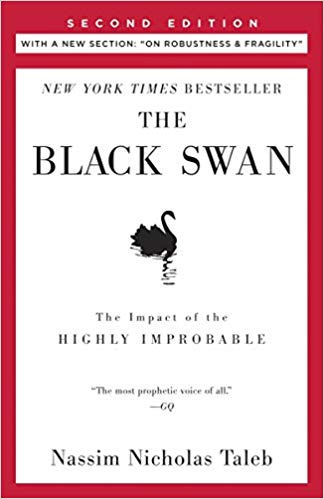

This article is an excerpt from the Shortform summary of "The Black Swan" by Nassim Taleb. Shortform has the world's best summaries of books you should be reading.
Like this article? Sign up for a free trial here .
What’s a grey swan? How does it serve as a metaphor for events that aren’t predictable, exactly, but imaginable?
A grey swan (alternately, gray swan) is a term for events that can’t be predicted but can be imagined. It can also refer to an event that’s unlikely but possible. The term was popularized by Nassim Nicholas Taleb in the book Black Swan.
We’ll cover what a grey swan is, how it fits in with black and white swans, and how to turn black swans grey.
Mediocristan, Extremistan, and Grey Swans
Before we can understand the concept of a “grey swan,” we need to know about black swans, Extremistan, and Mediocristan.
“Mediocristan” is Taleb’s term for the facets of our experience that are nonscalable. For example, like the income of a massage therapist, human physical traits such as height and weight hail from Mediocristan—they have upper and lower bounds, and if you were to graph every human’s height and weight, you would produce a bell curve. This is where normal, expected, white swans live (not grey swans).
Mediocristan’s overriding law can be stated thus: Given a large-enough sample size, no individual event will have a significant effect on the total. That is, there will be outliers—extremely heavy or tall people—but those outliers (1) will not be exponentially larger or smaller than the average, and (2) will be rendered insignificant by the sheer number of average cases. Most physical phenomena—human footspeed, trees’ rate of growth—come from Mediocristan. (Shortform note: Taleb sometimes treats Mediocristan as a distinct place, other times as an adjective to describe certain kinds of phenomena.)
“Extremistan,” oppositely, describes those facets of our experience that are eminently scalable. In Extremistan, inequalities are vast enough that one instance can profoundly affect the total. This is where black swans live and, sometimes, grey swans.
Most social (man-made) phenomena come from Extremistan. For example, wealth: It has no readily detectable upper limit; and if you were to include, say, Jeff Bezos, in any average of human wealth, you would produce a grossly distorted picture of how much money most people have.
Extremistan—Where Black (and Grey) Swans Fly
In the realm of Mediocristan, randomness is highly constrained (mild): There’s only so much variation in the physical aspects of our world. Thus, in Mediocristan, Black Swans are (effectively) impossible. Black Swans are extremely unpredictable events that have massive impacts on human society.
In Extremistan, however, randomness is highly variable (wild): No matter how large your sample size for a given phenomenon, you can’t produce a trustworthy average or aggregate picture because of the variation in that phenomenon. In Extremistan, Black Swans are frequent.
Thanks to the work of French mathematician Benoît Mandelbrot, some Black Swans can become “Grey” Swans—rare and surprising events that can be imaginable, if not precisely predicted. These grey swans aren’t as completely unexpected as black swans, but they’re related.
| Key Qualities of Mediocristan | Key Qualities of Extremistan |
| Nonscalable | Scalable |
| Typical member is mediocre (“average,” in the statistical sense) | Most members are dwarfs, a few are giants |
| Best-off are only marginally better than worst-off | Best-off are considerably better off than worst-off |
| Events are predictable from available information | Events are highly unpredictable from available information |
| Probability distribution is a bell curve | Probability distribution accords either with Mandelbrotian gray or “Grey” Swans or is dominated by Black Swans |
When we begin to analyze Extremistan in terms of the fractal paradigm, some Black Swans suddenly become “grey” swans—they’re not predictable with any sort of precision, but they are, at least, imaginable.
Representing Randomness: Fractals and Power Laws
So can the phenomena of Extremistan be modeled—and thereby predicted—at all? Not precisely; but they can be approximated—by the use of fractals. When they’re approximated, they become grey swans.
Developed by mathematician Benoît Mandelbrot in the 1970s, “fractals” are Mandelbrot’s coinage for geometric patterns that repeat at different scales. Fractals, unlike pure geometric shapes like triangles or circles, are seen quite frequently in nature. For example, a leaf’s veins look like little branches, and a tree’s branches look like little trees: the basic shape of the tree is echoed at the smaller scales.
The reason fractals are helpful in representing Black Swans is that their internal ratios stay constant across scales. Unlike bell curves, in which ratios decline at accelerating rates the further one gets from the average, fractals exhibit no (or mild) acceleration. They obey power laws, which describe a functional relationship between two quantities in which the relationship remains constant no matter what the initial size of the quantities.
For Extremistan phenomena, the power laws aren’t known with any certainty, but they can be approximated. Say, for example, you want to assess the risk of a stock portfolio, and you know that, based on past data, the worst-case scenario is a -5% move once every 2 years. With a power of 2—remember that the power is estimated—you can assume that a -10% move will happen once every 8 years (2^2=4) and a -20 percent move will happen once every 32 years. (For scale, in the 1987 crash, the U.S. stock market lost almost 23% of its value, an impossibility according to Gaussian economic models.) With fractal/power-law distributions, a 1000-year flood can become a 100-year one, and a 100-year one can become a 10-year one. Fractals can help turn black swan events into grey swan events and make them imaginable, if not entirely predictable.
Prepare for Grey Swans
Because Black Swans are, by definition, unpredictable, we’re better off preparing for the widest range of contingencies than predicting specific events. Grey swans are a little more imaginable than Black Swans, but they’re still unpredictable, so we should approach them the same way: Prepare for the effects of grey swans.
Though Black and Grey Swans themselves can never be predicted, their effects can be. For example, no one can predict when an earthquake will strike, but one can know what its effects will be and prepare adequately to handle them.
The same goes for an economic recession. No one can predict precisely when one will occur, but, using the “barbell strategy” or some other means of mitigating risk, we can at least be prepared for one.
———End of Preview———

Like what you just read? Read the rest of the world's best summary of "Black Swan" at Shortform . Learn the book's critical concepts in 20 minutes or less .
Here's what you'll find in our full Black Swan summary :
- Why world-changing events are unpredictable, and how to deal with them
- Why you can't trust experts, especially the confident ones
- The best investment strategy to take advantage of black swants






